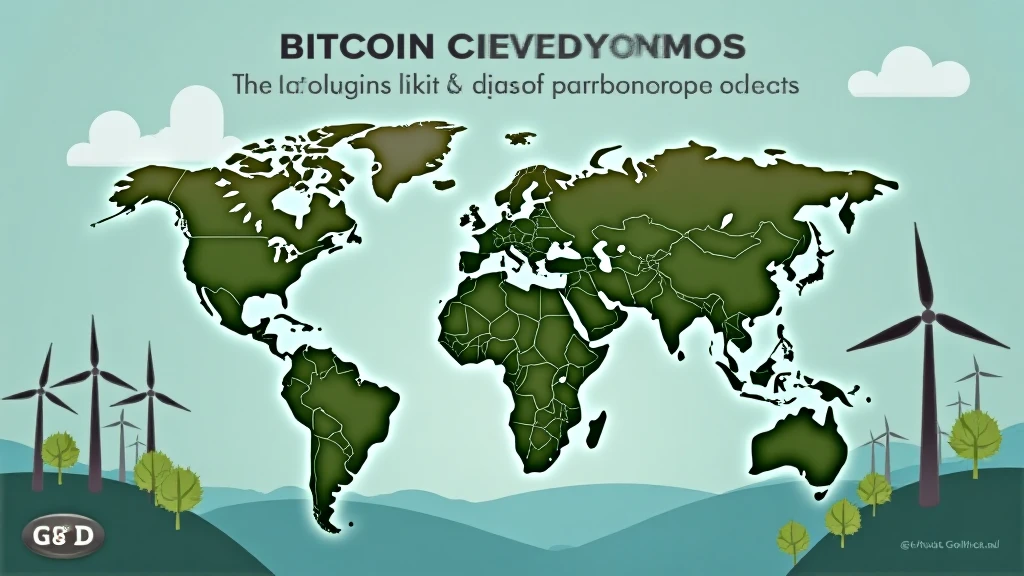Bitcoin Carbon Offset Programs: A Sustainable Approach to Cryptocurrency
With climate change becoming increasingly urgent, the crypto industry has begun to address its environmental impact. Bitcoin, as the leading cryptocurrency, faces scrutiny regarding its energy consumption and carbon footprint. In 2024 alone, it was estimated that Bitcoin mining emitted over 100 million tons of CO2, making it imperative to find solutions tailored to mitigate these effects. Enter Bitcoin carbon offset programs.
Understanding Carbon Offsets
Before delving into how Bitcoin can incorporate carbon offset programs, let’s clarify what carbon offsets are. Essentially, a carbon offset is a reduction in emissions of carbon dioxide (CO2) or other greenhouse gases made in order to compensate for emissions produced elsewhere. By investing in projects aimed at reducing carbon emissions—like reforestation, renewable energy initiatives, or waste management systems—individuals and companies can neutralize their carbon footprint.
Why Bitcoin Needs Carbon Offsetting
Bitcoin operates on a proof-of-work (PoW) consensus mechanism that necessitates extensive computational power. This leads to substantial energy consumption, primarily sourced from fossil fuels, contributing to greenhouse gas emissions.

- High Energy Consumption: According to the Cambridge Centre for Alternative Finance, Bitcoin mining consumes roughly 0.5% of the global electricity supply.
- Environmental Impact: A substantial portion of this energy is derived from non-renewable sources, leading to increased carbon emissions.
- Regulatory Scrutiny: As governments tighten regulations around environmental compliance, cryptocurrencies are coming under increased pressure, making carbon offsetting a viable solution.
How Bitcoin Carbon Offset Programs Work
Carbon offset programs associated with Bitcoin aim to balance the carbon emissions produced by mining activities through various offsetting strategies. Here’s a breakdown of how they operate:
1. Identifying Carbon Footprints
First, miners assess their carbon footprints based on electricity consumption and the sources of their power. By utilizing blockchain analytics, miners can track and report their energy usage transparently.
2. Investing in Carbon Offset Projects
Miners and investors can then purchase carbon credits to offset their emissions. Each credit typically represents one ton of CO2 reduced or removed from the atmosphere. This can involve funding projects like:
- Reforestation: Projects that plant trees to absorb CO2 from the air.
- Renewable Energy: Investments in solar, wind, or hydroelectric projects reduce reliance on fossil fuels.
- Energy Efficiency Programs: Initiatives that enhance energy use in various sectors, leading to lower consumption.
3. Reporting and Verification
Transparent reporting is crucial; thus, reputable projects undergo verification by third-party organizations to ensure the authenticity of carbon credits and their impact on emissions reduction.
The Role of the Cryptocurrency Community
Grassroots movements within the crypto community are crucial to promoting sustainable practices and increasing awareness regarding Bitcoin carbon offsets. Here are a few actions being taken:
- Awareness Campaigns: Educational efforts around energy consumption and sustainability, promoting responsible mining practices.
- Community Initiatives: Collectives that invest in carbon offset projects using community-raised funds.
- Partnerships: Collaborations between miners and environmental organizations to finance sustainable projects.
The Future of Bitcoin Carbon Offsetting
As interest in sustainable investing grows, the adoption of Bitcoin carbon offset programs is gaining momentum. According to data from Statista, the global carbon credit market is expected to reach $22 billion by 2025. This trend suggests a burgeoning market for sustainable practices within cryptocurrency.
Challenges Ahead
While promising, Bitcoin carbon offset programs face a few challenges:
- Greenwashing Risks: Some projects may exaggerate their impacts or fail to deliver real reductions in emissions.
- Market Volatility: The crypto market’s inherent instability can affect the funding available for carbon offset initiatives.
- Regulation Variability: Different regulations across jurisdictions complicate the establishment of universal carbon offset practices.
Case Studies: Successful Carbon Offset Initiatives
Here are some successful examples of Bitcoin carbon offset programs:
1. Bitcoin Mining Council
The Bitcoin Mining Council promotes sustainable mining practices by encouraging miners to transition to renewable energy sources. They provide resources and metrics for members to understand and mitigate their environmental impacts.
2. Project Vesta
Project Vesta is an initiative that aims to accelerate the weathering of volcanic rock to capture and store carbon. Bitcoin miners can contribute to this project to offset their emissions significantly.
Bitcoin Carbon Offset Programs in Vietnam
As the cryptocurrency market expands in Vietnam, addressing its environmental impact becomes crucial. With a user growth rate of 28% in 2024, initiatives promoting sustainability within the Vietnamese crypto community are likely to flourish.
- Local Partnerships: Miners in Vietnam can collaborate with environmental organizations to implement local carbon offset projects.
- Government Incentives: The government might introduce incentives for miners who adopt sustainable practices.
The Importance of Sustainable Practices
Sustainability is not just a buzzword; it is essential for the longevity of the cryptocurrency industry. By integrating carbon offset initiatives, Bitcoin can not only align with global sustainability goals but also enhance its overall credibility.
Considerations for Investors
Investors looking into Bitcoin should consider the environmental impact as part of their investment strategy. Here’s what to look for:
- Transparency: Ensure the miner or project provides clear information about their carbon offset strategies.
- Third-Party Verification: Opt for projects that are certified by credible environmental organizations.
- Community Impact: Assess how the project benefits local communities and promotes sustainable development.
Conclusion
As Bitcoin carbon offset programs evolve, they present an opportunity for the cryptocurrency industry to contribute positively to our global environment while addressing the scrutiny it faces regarding sustainability. By participating in these initiatives, miners, investors, and the broader crypto community can play a vital role in shaping a more sustainable future for Bitcoin and beyond.
By making conscious choices to offset carbon emissions, the Bitcoin community has the potential to become leaders in sustainability in the financial sector.
For more insights on cryptocurrency and its impact on the environment, stay tuned to officialcryptonews.
Author: Dr. Theo Nguyen, a recognized blockchain and environmental sustainability expert, has published over thirty research papers in the field and led audits for several notable carbon offset projects.




